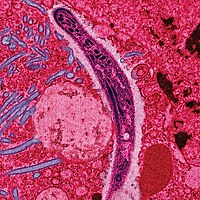
Photo from wikipedia
Schistosomiasis japonica caused by the trematode flukes of Schistosoma japonicum was one of the most grievous infectious diseases in China in the mid-20th century, while its elimination has been placed… Click to show full abstract
Schistosomiasis japonica caused by the trematode flukes of Schistosoma japonicum was one of the most grievous infectious diseases in China in the mid-20th century, while its elimination has been placed on the agenda of the national strategic plan of healthy China 2030 after 70 years of continuous control campaigns. Diagnostic tools play a pivotal role in warfare against schistosomiasis but must adapt to the endemic status and objectives of activities. With the decrease of prevalence and infection intensity of schistosomiasis in human beings and livestock, optimal methodologies with high sensitivity and absolute specificity are needed for the detection of asymptomatic cases or light infections, as well as disease surveillance to verify elimination. In comparison with the parasitological methods with relatively low sensitivity and serological techniques lacking specificity, which both had been widely used in previous control stages, the molecular detection methods based on the amplification of promising genes of the schistosome genome may pick up the baton to assist the eventual aim of elimination. In this article, we reviewed the developed molecular methods for detecting S. japonicum infection and their application in schistosomiasis japonica diagnosis. Concurrently, we also analyzed the chances and challenges of molecular tools to the field application process in China.
Journal Title: Pathogens
Year Published: 2022
Link to full text (if available)
Share on Social Media: Sign Up to like & get
recommendations!